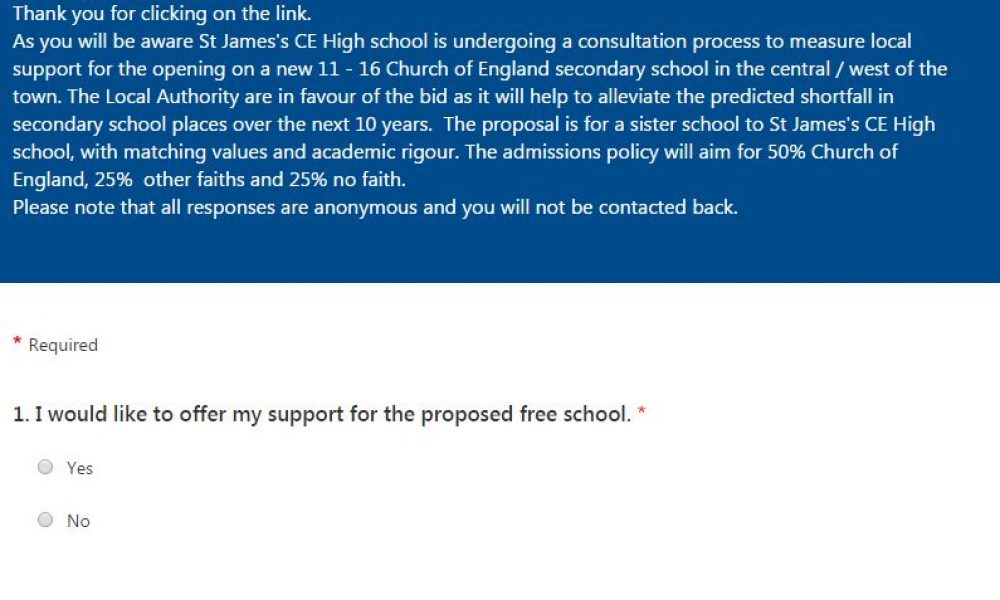A Church of England school is consulting on opening a free school which would break the 50 per cent cap on religious places – but said its website was “incorrect” when questioned by Schools Week.
St James’s Church of England High School in Bolton says on its website that it is consulting on opening a new free school which would admit 50 per cent based on pupils being Church of England, 25 per cent of “other faiths” and 25 per cent of “no faith”.
The proposal for the school, which would open in September 2019, would break current laws which say no more than half of places at new and over-subscribed schools may select pupils based on faith.
However, the Department for Education (DfE) backed the school’s right to propose 75 per cent of places for religious pupils, despite the school itself backing down when asked by Schools Week.
Headteacher Tania Lewyckyj said the “original literature that went out is incorrect” and the school was only proposing a 50 per cent cap on faith.
Lewyckyj would not answer why a consultation questionnaire for parents about the proposals still clearly stated it intended to open 75 per cent of places based on faith on the school’s website.
The questionnaire asks for expressions of interests regarding a proposed “sister school to St James’s CE High School, with matching values and academic rigour. The admissions policy will aim for 50 per cent Church of England, 25 per cent other faiths and 25 per cent no faith.”
Completed questionnaires such as these are often used by free school proposers to show demand for a school. It is not known if the school will void expressions of interest gathered using the mistaken criteria.
But the DfE defended the right of schools to propose the admissions criteria they wanted – even if these currently did not meet the requirements.
Free school proposers are at liberty at the consultation stage to propose any admissions criteria that they want
A spokesperson told Schools Week that there was “nothing to stop a free school proposer looking into the future” and “bearing in mind” the government’s education white paper, Schools that Work for Everyone.
The white paper, whose arrival date is uncertain, is likely to propose lifting the cap on new free schools so they could admit up to 100 per cent of pupils based on faith.
“Free school proposers are at liberty at the consultation stage to propose any admissions criteria that they want, and there’s nothing to stop them from doing that,” said the DfE spokesperson.
But the school has now said, even if the white paper went ahead and the cap was lifted, it would still “retain the 50 per cent cap, as we feel this is the best option in our community.”
Unions strongly criticised the DfE’s willingness to defend a free school proposal that is not permitted under current regulations.
Kevin Courtney, general secretary of the National Union of Teachers (NUT), said the DfE were “jumping the gun” by assuming the recent green paper would be agreed in Parliament, and should not be allowing free school proposals that “blatantly flout the law”.
Malcolm Trobe, interim general secretary of the Association of School and College Leaders (ASCL), said all current proposals should be “assessed under the current regulations”.








It looks like they are acting illegally on two counts. Firstly the admissions criteria breaches the 50% cap and secondly the criteria are not clear and transparent but are in fact confusing because of the contradictions and inherent lack of clarity (ie do non-Anglican Christians fall under “other faith”? Most Catholics or Methodists would say that they share the same faith as an Anglican).
And as the country becomes less religious why are schools becoming more religious.
Good to know the DfE backs schools proposing to break the Schools Admission Code as it currently stands. The Code is legally binding so the DfE is supporting schools acting against the Law.
They would also be in breach of the code by describing the final 25% as having “no faith”. Current regulation say that 50% of the places should be allocated “without reference to faith”, not that they should be reserved for children with “no faith”. In other words they needed to be allocated by some unrelated means, such as distance.